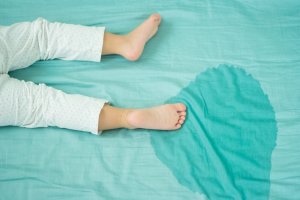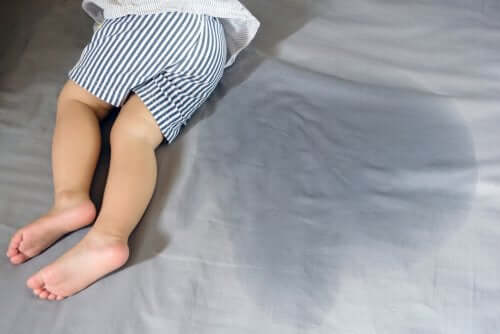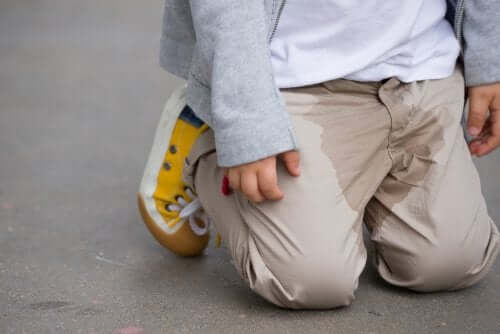Learn All About Secondary Enuresis


Written and verified by the psychologist Elena Sanz Martín
From two years of age, most children stop using diapers and start potty training. Some take longer than others. However, some children wet themselves again after a long period of dryness. Why does this happen? In this article, we’ll talk about secondary enuresis.
What’s enuresis?
Enuresis is the involuntary release of urine, either while awake or at night in bed. This issue must occur each day for at least three consecutive months and in children older than four.
While most children stop using diapers at age two, although this time varies depending on each person, a four-year-old should have no problem controlling their bladder. From this moment on, the situation can begin to be considered pathological.
This condition goes away spontaneously in a large percentage of children before they turn six. Still, it affects between 10 and 13% of six-year-old children and up to 8% of ten-year-olds.

Types of enuresis
Depending on when the incontinence occurs, enuresis can be classified into:
- Diurnal enuresis. Involuntary urination occurs during waking hours.
- Nocturnal enuresis. Urine leakage occurs only during sleep.
- A combination of both if urine emissions occur both during the day and night.
Another very important classification refers to whether the child already knows how to control their bladder or not. This way, we can distinguish:
- Primary enuresis. It occurs in children who have wet the bed since they were babies and have never been able to control their bladder.
- Secondary enuresis. Children who have experienced a period of dryness of at least six months and then suffer a relapse. For it to be considered as such, the involuntary emissions must reappear for at least six consecutive months.
The causes of secondary enuresis
- Hereditary component. The odds of suffering from enuresis increase from 15 to 44% if the child has a parent who had the same problem. The rate increases to 77% if both parents suffered from it.
- Organic causes. There may be an organic component, such as urinary tract infections. However, it’s very rare.
- Psychological causes. This is the most important factor in most cases of secondary enuresis. Anxiety or high psychological distress can lead to relapse. Stressful situations, such as a reprimand from a teacher, a fight with a friend, the death of a loved one, a divorce, or the arrival of a new sibling.
Guidelines for controlling secondary enuresis
- Openly discuss the issue. It isn’t advisable to ignore the situation nor become obsessed with it. The key is to speak honestly and seek solutions.

- Avoid punishment, blame, and anger. Always keep in mind that the child isn’t to blame. Thus, shaming and humiliating them isn’t beneficial. On the contrary, you should use positive reinforcement, praising and rewarding your child when they don’t wet the bed.
- It’s important for the child to adopt an active and responsible role in the process. Thus, they should change the wet bedding and follow all the guidelines we explain below.
- Urinating every two hours during the day and before bed and avoiding drinking liquids after dinner can prove helpful. Also, it’s beneficial for the child to use a calendar to keep track of the days they wet the bed and those they don’t.
- Bladder exercises can be a good complement to treatment. To do this, you can ask your child to hold their urine for a few seconds before urinating in the toilet or disrupt their urine flow several times while urinating.
- If all else fails, you may have to consider other options, such as bedwetting alarms or drug treatment. In any case, it’s always advisable to consult a professional.
From two years of age, most children stop using diapers and start potty training. Some take longer than others. However, some children wet themselves again after a long period of dryness. Why does this happen? In this article, we’ll talk about secondary enuresis.
What’s enuresis?
Enuresis is the involuntary release of urine, either while awake or at night in bed. This issue must occur each day for at least three consecutive months and in children older than four.
While most children stop using diapers at age two, although this time varies depending on each person, a four-year-old should have no problem controlling their bladder. From this moment on, the situation can begin to be considered pathological.
This condition goes away spontaneously in a large percentage of children before they turn six. Still, it affects between 10 and 13% of six-year-old children and up to 8% of ten-year-olds.

Types of enuresis
Depending on when the incontinence occurs, enuresis can be classified into:
- Diurnal enuresis. Involuntary urination occurs during waking hours.
- Nocturnal enuresis. Urine leakage occurs only during sleep.
- A combination of both if urine emissions occur both during the day and night.
Another very important classification refers to whether the child already knows how to control their bladder or not. This way, we can distinguish:
- Primary enuresis. It occurs in children who have wet the bed since they were babies and have never been able to control their bladder.
- Secondary enuresis. Children who have experienced a period of dryness of at least six months and then suffer a relapse. For it to be considered as such, the involuntary emissions must reappear for at least six consecutive months.
The causes of secondary enuresis
- Hereditary component. The odds of suffering from enuresis increase from 15 to 44% if the child has a parent who had the same problem. The rate increases to 77% if both parents suffered from it.
- Organic causes. There may be an organic component, such as urinary tract infections. However, it’s very rare.
- Psychological causes. This is the most important factor in most cases of secondary enuresis. Anxiety or high psychological distress can lead to relapse. Stressful situations, such as a reprimand from a teacher, a fight with a friend, the death of a loved one, a divorce, or the arrival of a new sibling.
Guidelines for controlling secondary enuresis
- Openly discuss the issue. It isn’t advisable to ignore the situation nor become obsessed with it. The key is to speak honestly and seek solutions.

- Avoid punishment, blame, and anger. Always keep in mind that the child isn’t to blame. Thus, shaming and humiliating them isn’t beneficial. On the contrary, you should use positive reinforcement, praising and rewarding your child when they don’t wet the bed.
- It’s important for the child to adopt an active and responsible role in the process. Thus, they should change the wet bedding and follow all the guidelines we explain below.
- Urinating every two hours during the day and before bed and avoiding drinking liquids after dinner can prove helpful. Also, it’s beneficial for the child to use a calendar to keep track of the days they wet the bed and those they don’t.
- Bladder exercises can be a good complement to treatment. To do this, you can ask your child to hold their urine for a few seconds before urinating in the toilet or disrupt their urine flow several times while urinating.
- If all else fails, you may have to consider other options, such as bedwetting alarms or drug treatment. In any case, it’s always advisable to consult a professional.
All cited sources were thoroughly reviewed by our team to ensure their quality, reliability, currency, and validity. The bibliography of this article was considered reliable and of academic or scientific accuracy.
- Graña, J. L., & Carrobles, J. A. I. (2014, 29 abril). Enuresis y desarrollo de la capacidad funcional de la vejiga: estudio comparativo con tres tratamientos conductuales. Recuperado de https://www.tandfonline.com/action/cookieAbsent
- Lapeña López de Armentia, S., Rodríguez Fernández, L. M., Marugán de Miguelsanz, J. M., Palau Benavides, M. T., Reguero Celada, S., Gutiérrez Fernández, M., . . . San Martín Sastre, J. L. (1996). Enuresis nocturna primaria y secundaria. ¿Son entidades diferentes? Recuperado de https://www.aeped.es/sites/default/files/anales/44-4-11.pdf
This text is provided for informational purposes only and does not replace consultation with a professional. If in doubt, consult your specialist.








